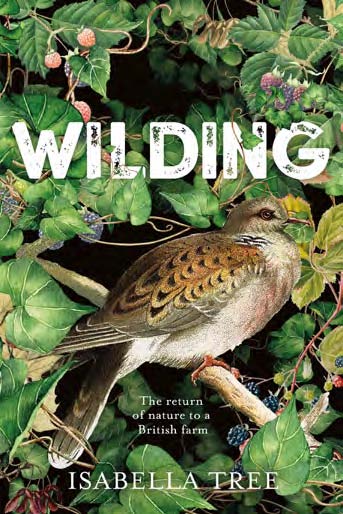From Living Woods issue 58
Woodland owner and farmer GUY LAMBOURNE ponders the value of wilding as a form of land management
 WILDING
WILDING
THE RETURN OF NATURE TO A BRITISH FARM
Isabella Tree
Picador
ISBN 978-1509805105
Paperback 384 pages
RRP £9.99
If I was writing a review for the back of this book I think ‘thought-provoking’ would do nicely. Given freedom to add another word, I’d go for ‘extremely thought-provoking’.
Written by the owner of the Knepp Estate, a large Sussex farming business, it is an account of Isabella and Charlie Tree’s experiences since the late 1990s of changing the family business from intensive arable and dairy farming to lightly controlled wilderness, funded both from the public purse and by a growing wild meat and tourism business.
On first reading, I was pretty shocked by the author’s demands that DEFRA and English Nature (as was), should fund a project that would not only take land out of production, but allow it to scrub up to become incapable of food production. Their proposal required the whole to be fenced to keep in deer and other stock. Bearing in mind that the whole estate is 3,500 acres, that’s one long fence – something like 9 miles and over £250,000-worth in 2009. The original scheme also proposed a land bridge to allow animals to cross the A272 safely. No figures were suggested for the cost of that and it hasn’t happened so far. A significant reason for choosing to withdraw from intensive agriculture was the problem of making a profit from the estate which lies on claggy Sussex clay.
There are mentions of a stud manager and polo ponies, descriptions of castles and ancient deer parks. I became outraged. Not because they wanted to take their farm out of food production, but because they wanted the government and EU to pay for it through Environmental Stewardship and were highly critical of those government bodies that didn’t move immediately to do their bidding. Moreover, I was angry because they felt entitled to receive funding and had the contacts and self-confidence to stir things up at a high level. So I had a bit of jealousy and class struggle going on beneath the surface.
I read the rest of the book in a bit of a lather and skimmed a whole lot of interesting things. These included the chapters about nightingales, butterflies, the Oostvaardersplassen, beavers, turtle doves, renewable power, ragwort, coppicing and forestry management. I wasn’t fully concentrating.
Luckily on second reading it all sunk in.
The book is full of amazing stuff and the research, both rigorous and more empirical, is building a wealth of knowledge. I hear wilding has reached The Archers and that’s about as mainstream as these things get. It has changed the way we are looking at the future of some of the land we look after and that’s quite an achievement.
I’ve calmed down a lot, but my initial unease remains. Should some wealthy landowners be paid large amounts of taxpayers’ money to abandon their 3,500 acres of farmland to nature? Or, to look at it another way, to allow their farm to become a haven for weeds and other vermin. Maybe we should look at it from a third way – the Knepp Estate has become an amazingly dense patchwork of habitats that attract wildlife on a scale and of a diversity not seen in England since the 17th century. So on balance I think I’d say yes, it’s money well spent.